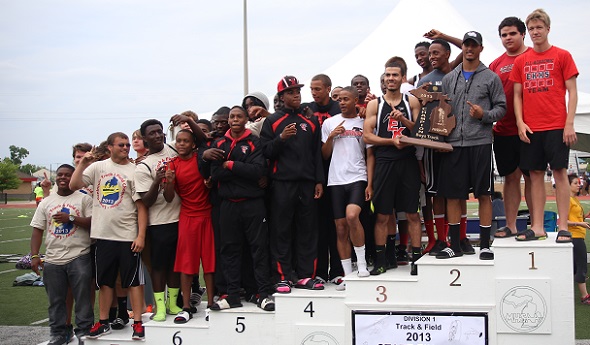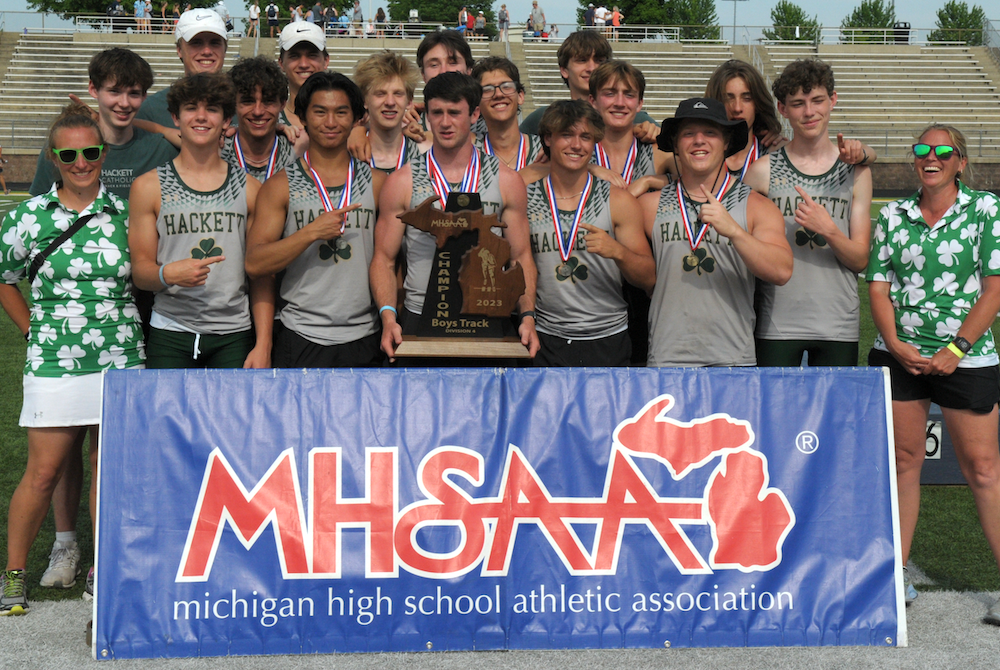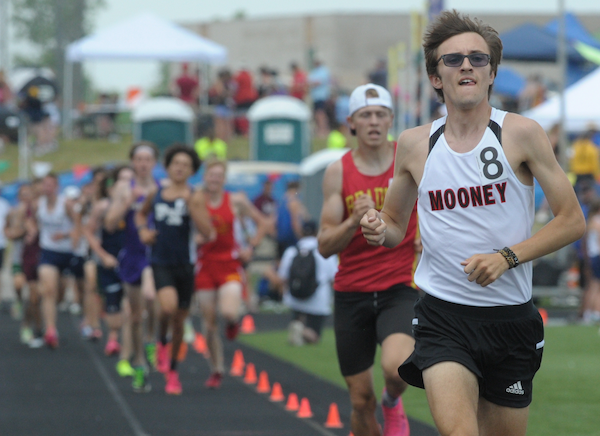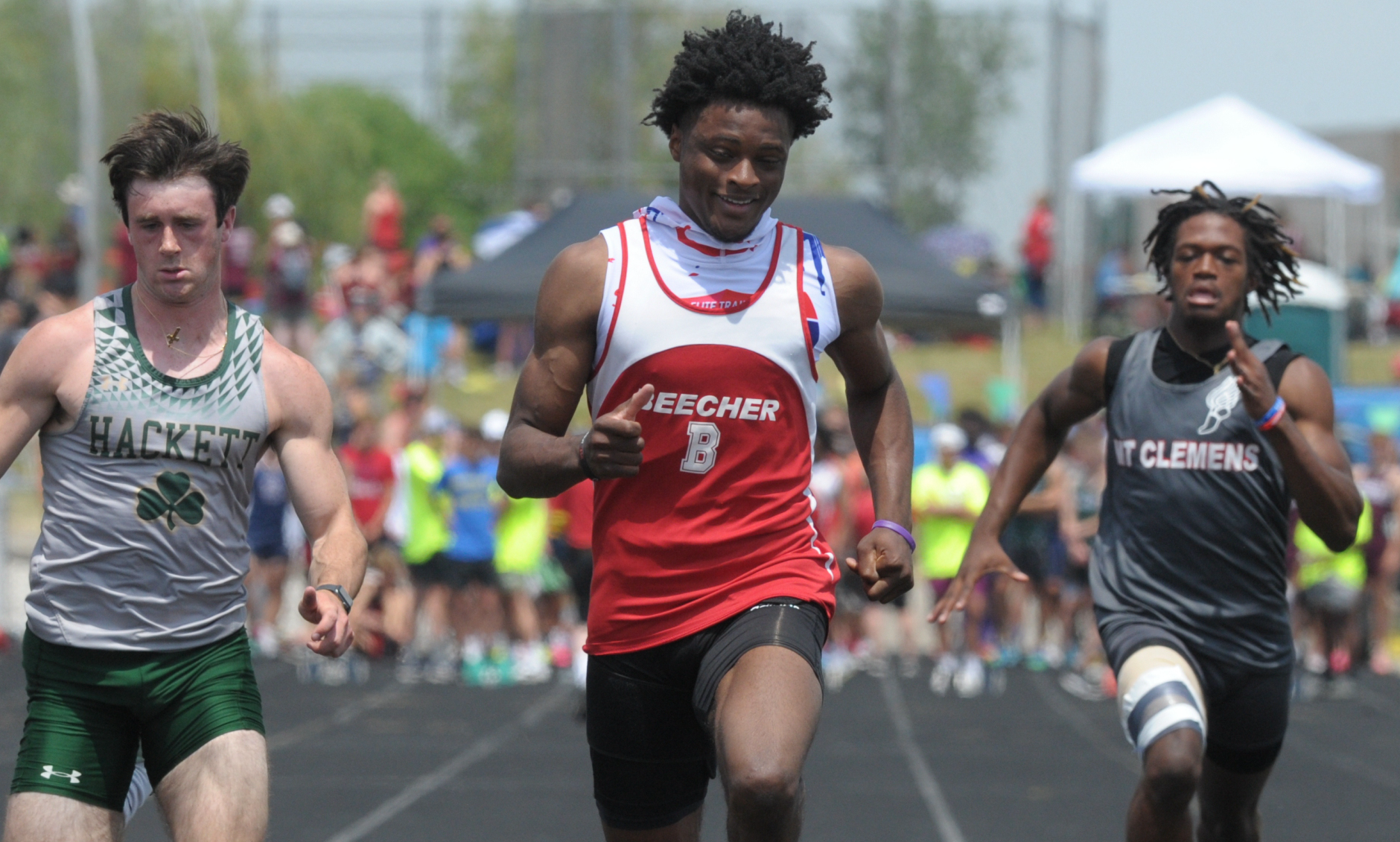
East Kentwood Follows Perfect Plan
June 1, 2013
By Tom Kendra
Special to Second Half
KENTWOOD – Devin McKinney and his East Kentwood teammates had a plan going into Saturday’s Lower Peninsula Division 1 Final.
“We knew that if we won our two relays, that we would win the meet,” explained McKinney, a star junior sprinter and hurdler for East Kentwood.
The host Falcons executed that plan to perfection and won the MHSAA team championship for the fourth time in the past five years – previously winning in 2009, 2010 and 2011, before placing eighth last spring.
East Kentwood did not have any individual event champions, but coach Dave Emeott’s team did have place-winners all over the board and then dominated the sprint relays to take the title with 43 points.
Grand Blanc was second with 32 points. The Bobcats were led by sophomore Grant Fisher, who won the 3,200-meter run and took second in the 1,600 meters, missing out on a double win by six thousandths of a second.
Lake Orion, paced by senior 1,600-meter champion T.J. Carey, placed third with 29 points, followed by Walled Lake Central (27) and Davison (24).
McKinney ran the anchor leg of East Kentwood’s winning 400-meter relay team (42.41) and ran the second leg on the winning 800-meter relay team (1:27.72). He also was third in the 110-meter high hurdles.
“I just wanted to bring it for my team,” McKinney said. “We really wanted to get that state championship back.”
McKinney was joined by Justin Harris, Onrekus Carter and Kewon Getter on the winning 400-meter relay team and Getter, Houston Glass and Kevin Smith on the 800-meter relay team.
 The threat of rain and possibly thunderstorms never materialized, but competitors had to deal with a steady wind throughout the day. The wind was blowing into the runners’ faces as they headed toward the finish line, resulting in higher-than-expected times in many events, particularly the sprints.
The threat of rain and possibly thunderstorms never materialized, but competitors had to deal with a steady wind throughout the day. The wind was blowing into the runners’ faces as they headed toward the finish line, resulting in higher-than-expected times in many events, particularly the sprints.
One athlete who said that going against the wind actually helped his performance was Walled Lake Central senior Cullen Prena.
Prena was the only boys athlete to win two individual events, even though he delivered an amazing end to his high school career away from the grandstands, in the throwing area.
Prena came in seeded second in the shot put, but overcame top-seeded Kevin Weiler of Swartz Creek with a winning throw of 60-11. But he was just getting warmed up. Prena hurled the discus more than 200 feet three times, including his final throw of 210 feet, 1 inch, which broke the old Division 1 Final record by more than 12 feet.
Afterward, Prena launched into an impromptu physics lesson to explain how throwing into the wind helped him.
“It was a perfect wind for the discus,” said Prena, who will compete in several major national events this summer, including the Chicago Throws Challenge and the New Balance Outdoor Nationals later this month before competing at the University of Oregon next year.
“A headwind is better because it gets under the disc and lifts it up. I felt great coming into today, and that wind just got me going even more.”
The discus win avenged his second-place finish in the event a year ago, when it was won by Matt Costello of Bay City Western, the Mr. Basketball winner who now plays for Tom Izzo at Michigan State.
While Prena was a shocking 34 feet further than the second-place thrower, most of the events were much closer.
Surprisingly, the closest race of the day was not in the 100-meter dash or a sprint relay. On a day when all eyes were on three of the top girls distance runners in the country in the 1,600-meter run, it was actually the boys’ 1,600-meter run which produced the day’s tightest finish.
Carey, a senior at Lake Orion, edged out Grand Blanc’s Fisher by the narrowest of margins, after the fans cheered both of them on as they ran neck-and-neck down the stretch. The final times showed Carey in first at 4:15.763 and Fisher second at 4:15.769 – a scant six thousandths of a second difference, which wasn’t official until a photo finish was used.
“I’m known for my kick and I needed every single bit of it today,” said Carey, a University of Missouri commit, with a grin. “It was the closest finish I’ve ever had, but I had a feeling that I got him right at the end.”
Fisher responded from that heartbreaking finish to capture the 3,200 meter title later in the meet.
Davison senior Gabe Hodge was a dual winner, capturing the 400-meter dash and then anchoring his team’s win in the meet’s final event, the 1,600-meter relay.
Saline captured the 3,200-meter relay title.
Other individual champions were Ato Condelee of Holland West Ottawa (long jump), Robert Atwater of Lincoln Park (high jump), Dylan Kole of Grand Rapids Kenowa Hills (pole vault), Freddie Crittenden of Utica (110-meter hurdles), Joshuwa Holloman of Auburn Hills Avondale (100 meters), Ross Williams of Birmingham Groves (300-meter hurdles), Andrew Middleton of Holt (800 meters) and Brandon Wilks of Southfield Lathrup (200 meters).
PHOTO: (Top) The East Kentwood boys track and field team poses on the medal stand after claiming the LP Division 1 championship. (Middle) Grant Fisher won the 3,200 in leading Grand Blanc to the team runner-up finish. (Photos by John Brabbs. Click to see more photo coverage from RunMichigan.com.)

Thrower Claims Lone Individual Title to Lead Hackett to Team 3-Peat
By
Tom Lang
Special for MHSAA.com
June 3, 2023
Kalamazoo Hackett Catholic Prep just keeps winning and winning.
This time the Irish took home their fourth title in the last five Lower Peninsula Division 4 Track & Field Finals, on Saturday at Hudsonville.
Hackett’s only individual title was taken by discus winner Nathan Buchmann, a senior, who was fine knowing he was the shortest in stature among all the sizable competitors.
“In the offseason after football I worked out every day, working towards this goal,” he said after getting his medal. “I would say this takes 80 percent technique and 20 percent strength to throw the discus. So, length can help but if you have good technique and are really strong, that will play into it.
“I think we are very balanced throughout the meet today,” he said about teammates that scored points in finishes other than first place. “We have 13 guys here today, and we have people in a lot of the races. But I do not run; I have too short of legs to be a fast runner,” he said with a chuckle.
Buchmann had to work through a hip injury to compete this spring.
“I think the setbacks are what make you strong,” he said. “You can either give up through the setbacks or push forward and become better.”
 Coach Charissa Dean agreed.
Coach Charissa Dean agreed.
“The kids have big hearts,” she said after all the points were totaled and the Irish were on top once again, with 53. “They worked hard. They had a lot of potential when we started the season. And we had a lot of drive to put in the work, and we are happy the results came out the way they did.”
Reading was runner-up at 47 points, followed by Wyoming Potter’s House Christian with 42, then Fowler and Flint Beecher each with 37 points.
Senior Lezawe “Moses” Osterink, of Potter’s House Christian, placed second in 1,600 but took the 3,200 title as defending champ of both. He dominated the latter by lapping the field with a final lap kick that resembled more of a superhero speedster.
“Nobody really took it out that hard at the start,” he said. “There was a freshman (Marek Butkiewicz of Hackett) that tried to get the pace going quick, but me and Dakota (Dykhuis of Montabella) just kind of sat back and gradually pulled him through.
“We took it gradually, and I was just relying that I could kick.”
Kick did he ever. The trio were neck and neck the majority of the race in a grouping ahead of the pack.
“With 400 to go I just tried to go all out,” Osterink said. “I had a lot more left than I thought and I was pleased with the win. Not really the time, but that doesn’t matter, especially this hot out.”
The overall meet was in the low 90s/high 80s heat and searing sun all day. So, race officials allowed the unique opportunity for coaches to spray the runners with water and give them water bottles.
“It was very weird because I’ve never taken water to drink while I’m running, so I didn’t know how that would feel,” Osterink said. “And they were spraying us and hitting us in the face. It was kind of fun.”
Junior Tyler Lenn of Marine City Cardinal Mooney defeated Osterink at his own game in the 1,600.
“I’m feeling great,” Lenn said after grabbing the medal. “I said to a newspaper after one of my races (during the season) I was right where I wanted to be. This has been a long rebuilding process for me since an injury back in the fall, and I set a pretty high goal the day the injury happened. I was telling myself I needed to fulfill what I said I would do at the beginning of last cross country season. And that is what I did today.”
Lenn suffered an ankle sprain from a misstep that turned worse because he kept running through the season on it.
“Coming back from that was pretty tough, but I wouldn’t have it any other way,” he said.  “Perseverance; I said from the beginning what I was going to do. I kept my eye on that target, and no matter the circumstances life threw at me, that I was going to make it happen and I am a man of my word.”
“Perseverance; I said from the beginning what I was going to do. I kept my eye on that target, and no matter the circumstances life threw at me, that I was going to make it happen and I am a man of my word.”
Jaylin Townsend, a senior from Flint Beecher, dominated the short races. He won the 100 dash (10.67) and 200 dash at 22 seconds flat. It was his third 100 win at a Finals.
“I put in a lot of work; I had to three-peat,” he said after the 100. “There’s a lot of great competition here, so I knew I had to come out and run my best.”
Concord in the 400 (43.72), Buckley in the 800 (1:30.76) and 1,600 (3:29.13) and Potter’s House in the 3,200 (8:14.18) were relay champs Saturday. Reading’s Tayshawn Bester won the 110 hurdles (15.13), and Athens’ Landen Bennett won the 300 (39.85). Caseville’s Nathan Feltner won the 400 (50.76), and Vestaburg’s Owen Patton claimed the 800 (1:55.11).
Fruitport Calvary Christian’s Bradley Richards won the high jump (6-10), and Peck’s Alex Affer won the long jump (23-4). McBain Northern Michigan Christian’s Isaac Bowden was first in pole vault (13-0), and Brown City’s Kyle Affer won shot put (49-2).
PHOTOS (Top) Kalamazoo Hackett Catholic Prep celebrates its third-straight LPD4 title Saturday. (Middle) Cardinal Mooney's Tyler Lenn, far right, sets the pace in the 1,600. (Below) Flint Beecher's Jaylin Townsend, middle, crosses the finish first for one of his two sprint championships. (Photos by Ken Swart/RunMichigan.com.)

